Hello,
I've been trying very hard to understand how to build the best enclosure for any specific speakers. My last project was a small bluetooth DIY speaker using two Visaton FR10 and a TDA7492P Sanwoo board which didn't please me that much.
I currently have some old car speakers laying around and i'm trying to use them to build another stereo speaker system. The speakers are two Hertz EV 130.5 4 ohm, two tweeters Hertz ET 26.5 4 ohm and two cross over Hertz CH200. Essentially they came as a kit. I also have an Yamaha rx396 amplifier with 50w at 8 ohm that i will use.
I've used WinISD to calculate the volume for the enclosure but that's where pretty much where i got stuck. It gave me a 31.9 litter cabinet with a 4.7 cm vent diameter and a 3.19 vent length.
Now, the vision in my mind is that i want them to be tower like enclosures. I don't know how to determine the best design for this(widh, height, lenght), where to place the vent port (the middle, down or how far from the speaker).
If anyone can help me with specific details due to the fact that i am very new at this and trying to understand logical way how to do it. Or any links to youtube or this forum tutorials (i've tried search but i don't know key words what to look for) i would appreciate it very much.
I've been trying very hard to understand how to build the best enclosure for any specific speakers. My last project was a small bluetooth DIY speaker using two Visaton FR10 and a TDA7492P Sanwoo board which didn't please me that much.
I currently have some old car speakers laying around and i'm trying to use them to build another stereo speaker system. The speakers are two Hertz EV 130.5 4 ohm, two tweeters Hertz ET 26.5 4 ohm and two cross over Hertz CH200. Essentially they came as a kit. I also have an Yamaha rx396 amplifier with 50w at 8 ohm that i will use.
I've used WinISD to calculate the volume for the enclosure but that's where pretty much where i got stuck. It gave me a 31.9 litter cabinet with a 4.7 cm vent diameter and a 3.19 vent length.
Now, the vision in my mind is that i want them to be tower like enclosures. I don't know how to determine the best design for this(widh, height, lenght), where to place the vent port (the middle, down or how far from the speaker).
If anyone can help me with specific details due to the fact that i am very new at this and trying to understand logical way how to do it. Or any links to youtube or this forum tutorials (i've tried search but i don't know key words what to look for) i would appreciate it very much.
Attachments
You should be able to put the port anywhere in the box and expect it to have the same interaction with the box at lower frequencies.
Read this, this is more or less the basics (altough not all is mandatory from what he says).
Loudspeaker Enclosure Design Guidelines
But in general, keep the driverrs close to each other, don't use cubes (except maybe for subs if they are not to big) and brace enough. Port can be everywhere, but if it will be close to a wall or floor when used, it will amplifiy the tuning frequency (the lower bass) and be less precise (choose what is more important for you).
Loudspeaker Enclosure Design Guidelines
But in general, keep the driverrs close to each other, don't use cubes (except maybe for subs if they are not to big) and brace enough. Port can be everywhere, but if it will be close to a wall or floor when used, it will amplifiy the tuning frequency (the lower bass) and be less precise (choose what is more important for you).
I'd build a classic box, not tower. A classic box means freestanding.
I see that the crossover (CH 200) crosses at about 3k5 Hz and uses a 0,33 mH coil for the lowpass. Tweeter uses 2nd order.
I'd build only the woofer box and keep the tweeter external.
Keep in mind that the different allocation of the sound source [speaker] from a car to a home is different, as it radiates differently due to being fixed on a surface and not in a box...well, it's called baffle step compensation, Allen B knows one or two things about it 😛
That would lead to a redesign of the lowpass for the woofer and to choose the right attenuation level for the tweeter
I see that the crossover (CH 200) crosses at about 3k5 Hz and uses a 0,33 mH coil for the lowpass. Tweeter uses 2nd order.
well, not really...! 🙄I'd build a classic box
I'd build only the woofer box and keep the tweeter external.
Keep in mind that the different allocation of the sound source [speaker] from a car to a home is different, as it radiates differently due to being fixed on a surface and not in a box...well, it's called baffle step compensation, Allen B knows one or two things about it 😛
That would lead to a redesign of the lowpass for the woofer and to choose the right attenuation level for the tweeter
Your fault is to think that you have to put this mid-woofer in a bass reflex box. A car-designed woofer however is designed to be used in an infinite-wall closed box, and relies on the small volume of the car to obtain useful bass. Moreover if you use the kit crossover on a standard box (i.e. not an infinite-wall box), it is likely you'll have thin bass as you'll have the baffle step effect, something that is avoided installing the woofer in the intended location (door of a car).I've used WinISD to calculate the volume for the enclosure but that's where pretty much where i got stuck. It gave me a 31.9 litter cabinet with a 4.7 cm vent diameter and a 3.19 vent length.
To obtain something useful keeping the original crossover you should design a large baffle closed box, and use a sub-woofer.
Ralf
Your fault is to think that you have to put this mid-woofer in a bass reflex box. A car-designed woofer however is designed to be used in an infinite-wall closed box, and relies on the small volume of the car to obtain useful bass. Moreover if you use the kit crossover on a standard box (i.e. not an infinite-wall box), it is likely you'll have thin bass as you'll have the baffle step effect, something that is avoided installing the woofer in the intended location (door of a car).
To obtain something useful keeping the original crossover you should design a large baffle closed box, and use a sub-woofer.
Ralf
You make a valid point, but since i'm a begginer you tell me !
Using square root of the volume, i got this speaker design using Qbasic code. What do you think ?
Attachments
You are wasting time and money building a bass reflex box for this woofer, it will sound awful. Optimum box is some 10L closed, a tradeoff between bass extension (limited), and power handling. But frankly, I would use those drivers only in a car, for the reasons specified before.
It would be far better to build a speaker designed by an experienced designer. For an example of a design with inexpensive drivers look here: Overnight Sensations or here: Classix II
Ralf
It would be far better to build a speaker designed by an experienced designer. For an example of a design with inexpensive drivers look here: Overnight Sensations or here: Classix II
Ralf
...the vision in my mind is that i want them to be tower like enclosures.
Keep in mind that most towers are actually ML-TLs not reflex boxes so WInISD won’t do the job.
The particualr alignment you are using i consider kinda ugly. One of the rules i follow is that the 1st derivative of the FR shuld only cross zero once, in each of yours you cross 3 times.
dave
You are wasting time and money building a bass reflex box for this woofer
Looks like it would be better in an OB as a midTweeter.
Butterworth Q sealed box is some 70+ litres. I see no decent reflex box. F(-10) 50 Hz, F(-6) in the mid 60s.
dave
What is an Optimum box? Where can i find designs. As for already made kits, no thanks. I like to build from scratch.
The two designs I suggested are open, you don't have to buy a kit, you can build boxes and crossover, as in the links you find the plans for the box and crossover. If you want to build something from scratch that have a guaranteed outcome, this is the easiest solution. You can get creative on the finishing, there are some examples in the links.
If you want to design a box for your car speaker, do first your homework and read the basics of enclosure design. I already suggested a 10L closed box as a good compromise, a reflex box is out of question. Is it optimal? No because there is no optimal box, there is only the best box for the intended application, and in this case the tradeoff is between bass extension and power handling. For a 10L box, use 15-20mm thick material (MDF or birch ply), put the drivers close together, and follow the point 4 in the article posted by waxx. But as I already said, for the best output you should use a very big baffle, otherwise you should also change the crossover as it is designed without the baffle step, but with a small baffle you do incur in the baffle step effect, and the result is a bass that is some dB lower than the mid and high. For this reason I wouldn't spend money and time in building a box for your car speaker, as the result will be poor. The only solution that can bring something out of this without changing the crossover is a very large baffle (at least 80 cm), with the use of a sub.
Ralf
If you want to design a box for your car speaker, do first your homework and read the basics of enclosure design. I already suggested a 10L closed box as a good compromise, a reflex box is out of question. Is it optimal? No because there is no optimal box, there is only the best box for the intended application, and in this case the tradeoff is between bass extension and power handling. For a 10L box, use 15-20mm thick material (MDF or birch ply), put the drivers close together, and follow the point 4 in the article posted by waxx. But as I already said, for the best output you should use a very big baffle, otherwise you should also change the crossover as it is designed without the baffle step, but with a small baffle you do incur in the baffle step effect, and the result is a bass that is some dB lower than the mid and high. For this reason I wouldn't spend money and time in building a box for your car speaker, as the result will be poor. The only solution that can bring something out of this without changing the crossover is a very large baffle (at least 80 cm), with the use of a sub.
Ralf
I support what has already been stated, using a car kit require:
- a new crossover design: with baffle step compensation and HF lpad resulting in lower sensitivity at 4ohm and possibly a bad match for your 8 ohm amp.
- expected thin bass no body with the lack of infinite baffle and the small car volume to support: you need a sub, this 5” at best is a midrange in home use.
- low expectations in general: you should only do this for practice, don’t expect it to be a good project.
I just did the same with a car kit. It was a waste of time really but some experience was gained.
My advice. Create a simple open baffle 30x45cm and use the kit with modified xo as a computer desktop near field with an active 8” sub to support just for fun, then start a new project for the towers in mind.
- a new crossover design: with baffle step compensation and HF lpad resulting in lower sensitivity at 4ohm and possibly a bad match for your 8 ohm amp.
- expected thin bass no body with the lack of infinite baffle and the small car volume to support: you need a sub, this 5” at best is a midrange in home use.
- low expectations in general: you should only do this for practice, don’t expect it to be a good project.
I just did the same with a car kit. It was a waste of time really but some experience was gained.
My advice. Create a simple open baffle 30x45cm and use the kit with modified xo as a computer desktop near field with an active 8” sub to support just for fun, then start a new project for the towers in mind.
- Home
- Loudspeakers
- Multi-Way
- Help enclosure design




